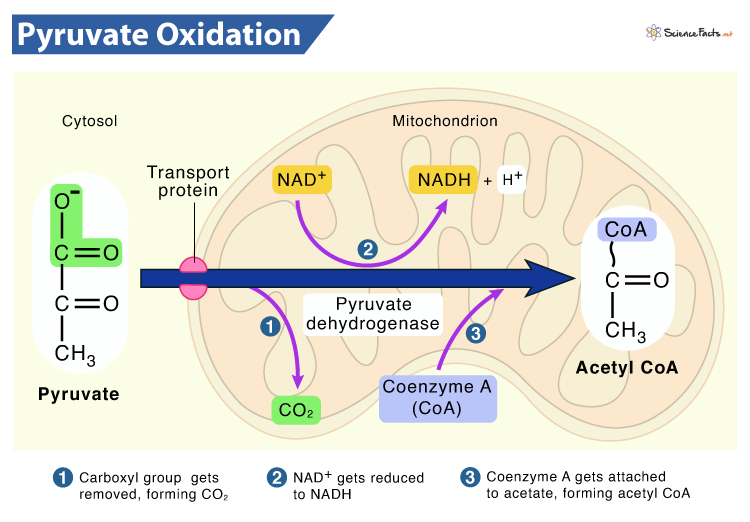Pyruvate Oxidation
What is Pyruvate Oxidation
Pyruvate oxidation, also known as pyruvate decarboxylation or link reaction, is a connecting step of cellular respiration, linking glycolysis and the Krebs cycle. Here, pyruvate gets oxidized to acetyl-CoA under the influence of the enzyme complex pyruvate dehydrogenase.
At the end of glycolysis, a single glucose molecule splits into two pyruvates (C3H4O3). Due to this, the link reaction occurs twice for each glucose molecule yielding a total of 2 acetyl-CoA molecules. This acetyl CoA then enters the Krebs cycle or citric acid cycle and fuels the reactions.
Location: Where does Pyruvate Oxidation Occur
In eukaryotes, this process takes place in the mitochondrial matrix, the innermost compartment of mitochondria.
In prokaryotes, it occurs in the cytoplasm.
Steps of Pyruvate Oxidation
After glycolysis, the pyruvate molecules leave the cytoplasm and enter the mitochondrial matrix crossing its inner membrane with the help of a transport protein. It is a type of active transport, as this crossing requires energy. In the mitochondrial matrix it undergoes several changes before entering the next step of cellular respiration. This ensures that energy stored in the pyruvate molecules can be harnessed by the cells.
This conversion takes place in three steps:
Step 1: Initially, the enzyme pyruvate dehydrogenase removes the carboxyl group from the 3-carbon molecule, pyruvate, releasing carbon dioxide. As a result, a two-carbon hydroxyethyl group bound to the enzyme is left behind.
Step 2: In the next step, the two-carbon molecule from the previous step gets oxidized. NAD+ picks up the electrons lost in the oxidation to form NADH. Thus, NAD+ gets reduced to NADH, forming acetate.
Step 3: Finally, coenzyme A, a sulfur-containing compound derived from vitamin B5, gets attached to the acetate via its sulfur atom, yielding acetyl coenzyme A, or acetyl CoA. This acetyl CoA acts as a carrier molecule, carrying the acetyl group to the citric acid cycle.
Chemical Equation
Overall, this oxidation reaction converts pyruvate (a three-carbon molecule) into acetyl CoA (a two-carbon molecule), producing an NADH and releasing one carbon dioxide molecule in the process. As two pyruvates are produced from glycolysis for each glucose molecule, the overall process generates 2 molecules of each product.
2 Pyruvate + 2 NAD+ + 2 CoA → 2 Acetyl-CoA + 2 NADH + 2 CO2 + 2 H+
Simplified as,
Pyruvate + NAD+ + CoA → Acetyl-CoA + NADH + CO2 + H+
Reactants
1. Pyruvate
2. NAD+ – Nicotinamide adenine dinucleotide (oxidized)
3. CoA – Coenzyme A
Products
1. Acetyl-CoA – Acetyl coenzyme A
2. NADH – Nicotinamide adenine dinucleotide (reduced)
3. CO2 – Carbon dioxide
4. H+ – Hydrogen ion or proton
-
References
Article was last reviewed on Friday, February 4, 2022




